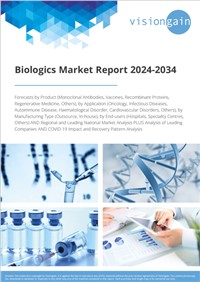The Biologics Market Report 2024-2034: This report will prove invaluable to leading firms striving for new revenue pockets if they wish to better understand the industry and its underlying dynamics. It will be useful for companies that would like to expand into different industries or to expand their existing operations in a new region.
Advances in Regenerative Medicine and Cell Biology Driving Market Growth
Advancements in cell biology and regenerative medicine are driving market growth by laying a robust foundation for stem cell-based therapies targeting a range of disorders, including cardiovascular, oncological, metabolic, and musculoskeletal conditions. These groundbreaking treatments offer global patients the potential for transformative strategies in handling complex medical challenges. Continued exploration and innovation in this field are poised to achieve further milestones, ushering in a future where debilitating illnesses can be effectively managed, and in some cases, even eliminated. Companies like Editas Medicine, CRISPR Therapeutics, and Intellia Therapeutics leverage CRISPR-Cas9 gene editing technology for potential gene therapies and regenerative medicine applications, aiming to rectify genetic disorders at the molecular level. Additionally, Vericel’s FDA-approved MACI (Matrix-Induced Autologous Chondrocyte Implantation) utilizes a patient’s own cells to repair knee cartilage defects.
Challenges Posed by Patent Expiration for Biologics
The expiration of patents on the initial biologics generation is paving the way for increased competition as biosimilars are poised to enter the market soon. Biosimilars, designed to replicate the qualities of previously approved biologic therapies, are gaining momentum worldwide, driven by governments aiming to reduce healthcare costs. Notably, the Central Drugs Standard Control Organization (CDSCO) in India has introduced the “Guidelines on Similar Biologics” to boost the Indian biosimilars industry. The biologics field in biotechnology is rapidly evolving, with over 60% dedicated to treating diabetes, autoimmune disorders, and cancer, resulting in high and escalating costs. Recognizing the barrier posed by these high prices, the World Health Organization (WHO) highlights an opportunity for generic drug manufacturers to produce biosimilar versions as patents expire. Generic drug producers are actively seeking biologics with impending patent expirations, with 230 drug patents set to expire between 2021 and 2025. Notable biologics expiring in 2024 include PERJETA (Pertuzumab), VYROLOGIX (Leronlimab), and STELARA (Ustekinumab). The Center for Biosimilars notes that while biologics currently constitute half of the oncology pharmaceutical industry, the expiration of nearly 20 oncology biologics’ patents by 2024 could lead to increased use of biosimilars in cancer treatment, contributing to lower overall costs.
What Questions Should You Ask before Buying a Market Research Report?
- How is the biologics market evolving?
- What is driving and restraining the biologics market?
- How will each biologics submarket segment grow over the forecast period and how much revenue will these submarkets account for in 2034?
- How will the market shares for each biologics submarket develop from 2024 to 2034?
- What will be the main driver for the overall market from 2024 to 2034?
- Will leading biologics markets broadly follow the macroeconomic dynamics, or will individual national markets outperform others?
- How will the market shares of the national markets change by 2034 and which geographical region will lead the market in 2034?
- Who are the leading players and what are their prospects over the forecast period?
- What are the biologics projects for these leading companies?
- How will the industry evolve during the period between 2024 and 2034? What are the implications of biologics projects taking place now and over the next 10 years?
- Is there a greater need for product commercialisation to further scale the biologics market?
- Where is the biologics market heading and how can you ensure you are at the forefront of the market?
- What are the best investment options for new product and service lines?
- What are the key prospects for moving companies into a new growth path and C-suite?
You need to discover how this will impact the biologics market today, and over the next 10 years:
- Our 312-page report provides 127 tables and 213 charts/graphs exclusively to you.
- The report highlights key lucrative areas in the industry so you can target them – NOW.
- It contains in-depth analysis of global, regional and national sales and growth.
- It highlights for you the key successful trends, changes and revenue projections made by your competitors.
This report tells you TODAY how the biologics market will develop in the next 10 years, and in line with the variations in COVID-19 economic recession and bounce. This market is more critical now than at any point over the last 10 years.
Forecasts to 2034 and other analyses reveal commercial prospects
- In addition to revenue forecasting to 2034, our new study provides you with recent results, growth rates, and market shares.
- You will find original analyses, with business outlooks and developments.
- Discover qualitative analyses (including market dynamics, drivers, opportunities, restraints and challenges), cost structure, impact of rising biologics prices and recent developments.
This report includes data analysis and invaluable insight into how COVID-19 will affect the industry and your company. Four COVID-19 recovery patterns and their impact, namely, “V”, “L”, “W” and “U” are discussed in this report.
Segments Covered in the Report
Product Outlook
- Monoclonal Antibodies
- Human
- Humanized
- Chimeric
- Murine
- Vaccines
- Recombinant Proteins
- Regenerative Medicine
- Tissue Engineered Products
- Cell Therapy
- Gene Therapies
- Others
Application
- Oncology
- Infectious Diseases
- Autoimmune Disease
- Haematological Disorder
- Cardiovascular Disorders
- Others
Manufacturing Type
- Outsource
- In-house
End-users
- Hospitals
- Speciality Centres
- Others




